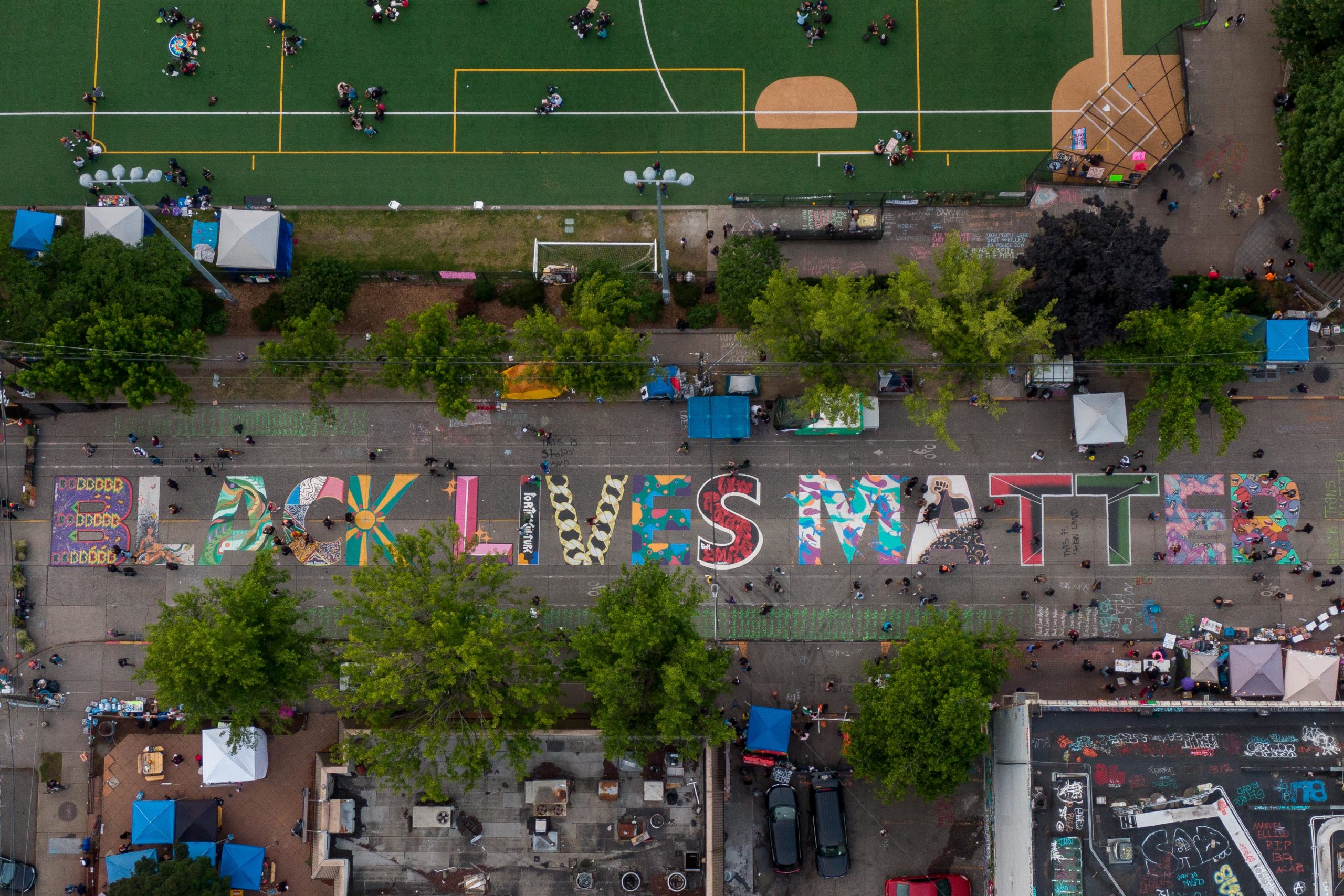Political Report
Seattle Cut Its Police Budget. Now the Public Will Decide How To Spend the Money.
The city will use participatory budgeting to allocate $30 million to programs that create “true public health and safety.”

The city will use participatory budgeting to allocate $30 million to programs that create “true public health and safety.”
Most cities finalized their 2021 budgets last year in the usual way, with mayors, city managers, and council or commission members hashing out the details. But in Seattle, residents will get to decide over the coming months how to spend millions of dollars that would otherwise go to the police department.
In the wake of protests against the police murders of George Floyd, Breonna Taylor, and so many other Black people, a movement to defund police departments has taken shape across the country. Last year, organizers in many cities created “people’s budgets” that showed how officials could cut police funding and invest in housing, health care, and other social services.
Few cities cut police department budgets in response to public pressure, but of those that did, Seattle went a step further in November by allocating $30 million to a participatory budgeting process that will give everyday people a say in how the money should be used. Twelve million dollars was directly diverted from the Seattle Police Department, while the remaining $18 million comes from Mayor Jenny Durkan’s Equitable Communities Initiative Fund, which is sourced from cuts to several departments and new taxes.
“Those closest to the problems are closest to the solutions,” reads a statement signed by 75 local organizations that advocated for what they call a solidarity budget. “Black, brown, Indigenous, and immigrant communities are most harmed by COVID-19, climate injustice, racism, and criminalization, and should be central to the process of transforming Seattle’s budget into one that serves all people.”
Throughout the summer and fall of 2020, the groups called for a budget that divests from policing and uses participatory budgeting—a governance model with roots in Brazil—to invest in “priorities that can generate true public health and safety for all Seattle residents.”
“That really put forward a strong vision for the city that could then be strengthened and reiterated by folks who were marching and protesting, who were having meetings with their [elected officials] and seeking to hold folks accountable,” said Kristania De Leon, the director of partnerships and strategy at the Participatory Budgeting Project, a national organization that supports local campaigns.
Two coalitions in particular, King County Equity Now and Decriminalize Seattle, worked to channel momentum from the streets into the city’s budgeting process, demanding that the City Council defund the Seattle Police Department by at least 50 percent and “reinvest that money into Black communities and toward community-led health and safety systems.”
“It was just a good combination of having the policy demands prepared, at the moment when the social movement opportunity provided us that opening. But without the movement on the ground, this wouldn’t have happened,” said Angélica Cházaro, an organizer with Decriminalize Seattle and assistant professor at the University of Washington School of Law.
On Nov. 23, after an eight-week series of City Council meetings, more than 160 amendments, and vetoes by Mayor Jenny Durkan, the final budget announced by Councilmember Teresa Mosqueda, chairperson of the Budget Committee, included an 18 percent cut to the police department, a portion of which was reallocated to participatory budgeting.
“As we have throughout this spring and summer, we led with investments in our BIPOC community and support for our most vulnerable families and small businesses,” said Mosqueda in a media release. The budget also includes an agreement to reassess the participatory budgeting plan monthly and potentially increase the pot of funding.
The concept for participatory budgeting was cemented in the 1980s by the Brazilian Workers’ Party, which sought to push past the electoral process and envision new ways of practicing democracy. In the U.S., participatory budgeting was piloted in 2009 when residents of Chicago’s 49th Ward demanded greater transparency about how the city was spending public funds. The interest in Chicago inspired residents in other cities like San Francisco and New York City to organize community-led budgeting projects.
In 2019, New Yorkers participated in planning and voted on $39 million in projects in 32 City Council districts across the city, which has been one of the largest-scale participatory budgeting programs in the U.S. to date. Improvements to parks, libraries, public housing, and transportation are some of the things that participatory budgeting has funded. (The process was canceled in 2020 because of the coronavirus outbreak, but has been revived this year in some districts.)
Participatory budgeting is part of a global movement for solidarity economies, says Natalia Linares, communications organizer for the New Economy Coalition. The vision for the solidarity economy movement “also includes other elements like building the movement for worker owned cooperatives, building the movement for community land trusts, [and] permanently affordable housing,” she said. The Movement For Black Lives has also included participatory budgeting in its platform as part of a broader vision for community control of laws, institutions, and policies.
The idea of participatory budgeting came to fruition in Seattle during its 2015 Youth Voice, Youth Choice program that allowed young residents to give their input for neighborhood-level projects. Since 2017, all residents have had the opportunity to vote on improvements to streets, sidewalks, and parks.
“I think one of the things that helped is that City Council members … were familiar with the idea of [participatory budgeting], it wasn’t completely new to them,” said Cházaro. But those earlier iterations have involved allocating just a few million dollars and were limited to projects carried out by the Seattle Department of Neighborhoods, the Department of Transportation, and Parks and Recreation. Now, the pot of money is tens of times bigger and comes from a general fund, meaning it can be used for projects, and also ongoing programs, within most city departments.
King County Equity Now is doing research that will inform how the participatory budgeting process will actually play out. Cházaro said they intend to involve community groups from across the city, including many Black-led organizations that have been fighting for racial justice for a long time. “This [activism] is built on … years and years of abolitionist organizing in Seattle,” she said.
The group reported that it has put together a team of more than 100 community-based researchers, “including youth, elders, people with different levels of experience in the criminal legal system, artists, healers, [and] educators].” Members of this research team are conducting online surveys (which are available in multiple languages) and in-person conversations in communities of color to identify needs and potential barriers to individuals getting involved in participatory budgeting.
“The deep history, rich legacy and strength of Black organizing in this region helped lay the foundation for much of this work,” a King County Equity Now spokesperson said in an email.
Their goal is to come up with strategies to make the process accessible to as many people as possible, including those experiencing homelessness and housing instability, people with disabilities, and formerly incarcerated people. They are also figuring out how to create an online participation system to ensure safety during the COVID-19 pandemic, which may require strategies for making internet access more widely available. Cházaro highlighted that organizers in Seattle “fought for money for Black-led research to inform participatory budgeting,” and ultimately received $3 million for this planning stage.
Some local reporters have cast doubt on the effectiveness of the research and raised questions about how the money is being spent. Tammy Morales, the council member working directly with King County Equity Now, did not respond to a request for comment from The Appeal: Political Report in time for publication, but in December she rebuked a skeptical blogger, saying in an email that “Contracts which have predated this one haven’t received the same kind of scrutiny you’re offering here. So, I find it interesting that this particular contract has received so much attention from the onset.”
Morales added that, “Participatory research is about building the capacity of our neighbors to understand what’s happening in their community and to increase civic engagement so they can inform future policy-making…To suggest that a greater standard or threshold is in order is to dismiss the people who stand to benefit most from this approach.”
In a presentation last month, organizers spoke about forming a steering committee made up of community members who will collaborate with multiple city departments to create a strategy for the participatory budgeting process based on this initial research. The process will include reviewing community-generated proposals, and creating a list of projects and programs that could receive funding, which community members will then vote on.
De Leon from the Participatory Budgeting Project said that the goal is not to create one-time projects and hope that sustained equity will come out of that; this is just one step that’s part of a larger vision of justice. “We’re looking at this as a system’s change. And it needs to be a long term, deep commitment.”
This story has been updated to include a comment from King County Equity Now.
This article was produced in partnership with Just Media, a national hub supporting young writers covering justice issues.
